ISC Physical Education Previous Year Question Paper 2017 Solved for Class 12
Section-A (40 Marks)
Answer any five questions.
Question 1.
Discuss the role of Physical Education in the development of an individual through the medium of games and sports. [8]
Answer:
- Games and sports help not only in physical fitness but also the psychological. A combination of physical and psychological fitness leads to an overall development of an individual.
- Games and sports help an individual to maintain a good shape and size of the body.
- They also help in the improvement of the physiological capacities of the various systems of the body. Games and sports affect not only the physical and physiological aspects of the body but also the psychological fitness.
- They help to improve perception, emotional stability, motivation and intelligence of an individual.
- They help the individual to bear stress and tension better. Therefore, we can see that games and sports helps in the overall development of an individual.
Question 2.
Explain the procedure of conducting circuit training, with the help of a diagram. Explain any four benefits of circuit training. [8]
Answer:
Circuit training is a form of body conditioning or resistance training using high- intensity aerobics. It targets strength building or muscular endurance. An exercise “circuit” is one completion of all prescribed exercises in the program.
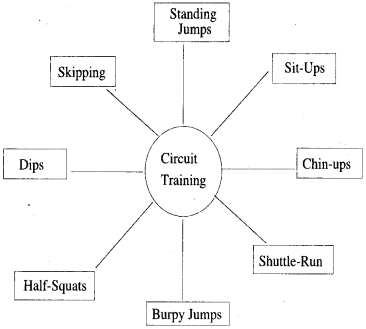
Four benefits of Circuit Training :
- Get Maximum Results in Minimum Time : Circuit training is the perfect workout for the time-crunched fitness fiend. You can set up as many or as few stations as you like and then continue through the circuit until your time runs out. You can fit it in effective, total-body workout whether you have 15 min or an hour.
- Send your Metabolism Soaring : Circuit training kicks your fat-burning furnace into high gear. You’ll torch more calories in 20 minutes than you would in an entire hour on the elliptical reading a magazines. Plus, the afterbum effect will have you torching calories for up to 48 hours after your workout ends.
- Never Waste Another Minute : It’s easy to swap out one station for a different exercise and still get the same great workout.
- Beat Gym Boredom : Circuit training is such a flexible format, the options in how you set up your workout are limitless. Whether you like to stick to one routine for a while to measure your progress or prefer mixing it up every time you go to the gym, having a plan will makes you more confident and efficient.
Question 3.
Explain the meaning of weight training. Write any eight weight training exercises. [8]
Answer:
Weight training is a common type of strength training for developing the strength and size of skeletal muscles. It utilizes the force of gravity in the form of weighted bars, dumbbells or weight stacks in order to oppose the force generated by muscle through concentric or eccentric contraction. Weight training uses a variety of specialized equipment to target specific muscle groups and types of movement.
(1) Bodybuilding : Bodybuilders train in a specific manner to achieve a specific goal making their muscles bigger. They tend to lift in the eight- to 12-rep range and only train one muscle group per day, per week. This type of training is the best for making your muscles larger but not necessarily stronger.
(2) Power Lifting : Power lifting is the best type of training for maximal strength what many people would consider “brute” strength. A power lifter’s goal isn’t appearance, it’s strength. Power lifters focus on lifting an extremely heavy amount of weight for only a few repetitions.
Circuit Weight Training : Circuit weight training is when you do a number of exercises in quick succession, usually lifting a light amount of weight for a high number of repetitions. For example, doing 20 bench presses, 20 squats and shoulder presses with little or no rest in between. This type of training is ideal for burning fat, increasing endurance and making some gains in strength.
(4) Isometric Weight Training : Isometric weight training is when you hold a weight up in one position for a given amount of time without going through a range of motion. For example, holding a dumbbell straight in front of you for 30 seconds. This type of training increases your stamina and makes you stronger in the positions you hold.
(5) High-Volume Training : High volume training is similar to body building in the sense that you only work your muscle groups once a week. This type of training places a strong emphasis on increasing muscular endurance one exercise at a time. Not only does it make your muscles larger, it also makes them better at keeping up a certain amount of resistance for a long period of time. It is done is by performing one exercise at a time, lifting the same amount of weight 10 times for 10 sets. Each week, you try to increase the amount of weight slightly.
(6) Resistance Bands : With resistance bands you can strengthen and tone all the major muscle groups. The advantage of resistance bands is that you can adjust the resistance, using less resistance when needed or increasing the resistance to increase the challenge.
(7) Pull-Ups : A pull-up is when your hands are facing away from you. This will work your back and biceps.
(8) Back Squat: This is the squat movement where the biggest amount of weight is moved. This is the one and original squat movement which has been around for as long as people have been lifting weights.
Question 4.
What is International Olympic Committee (IOC) ? Write any five functions of the IOC. [8]
Answer:
The body that governs the Olympic Games is the International Olympic Committee (IOC). This is a non-governmental organization that was created on June 23rd 1894, Paris, France based in Lausanne Switzerland, by Baron Pierre De Coubertin. IOC is the governing body of Modem Olympic Games.
Main Role-Functions of International Olympic Committee (IOC) : As IOC being the governing body, it has various roles and functions. The roles and functions are as follows :
- To boost support and promote ethics in games and sports.
- To encourage and support the organization, its progress, coordination of sports and sporting competition.
- To act in contradiction of any form of discrimination that disturbs the Olympic Movement.
- To execute the principle of equality between men and women by encouraging and supporting in elevating the women in sports at all level.
- To fight against illegal practices by atheletes (doping) in sport.
Question 5.
What is meant by correct posture ? Explain any two common postural deformities. [8]
Answer:
Correct posture means the balancing of body in accurate and proper manner while sitting, standing, reading and writing, walking, running or during any other action.
Postural deformities imply not having proper alignment of body parts. An individual who has postural deformities cannot perform his work efficiently. Some postural deformities are kyphosis, flat foot, knock knee etc.
(1) Lordosis : Lordosis denotes or indicates increased anterior curvature of spine. It is an exaggeration or increase in the amount of the normal concavity of the lumber region of the spine, i.e., an increase in the extension curve of the lumber region beyond normal region. It is inward curvature of the spine with protruding abdomen resulting in hollow back.
(2) Scoliosis : The term scoliosis is derived from a Greek word, which actually means twisting or bending. Scoliosis means a lateral bending of spine to one or more sides from midline. It is an exaggerated lateral curvature i.e. sideward curvature or deviation of the spine, with the shoulder lower and hip higher on one side. It may be present in a very small part of spine or it can involve the whole or major part of spine. Usually there is a single curve in one direction only and called ‘C’ curve scoliosis. When two or more than two lateral curves are present in the spine, that is called ‘S’ curve scoliosis or compound and double scoliosis.
Question 6.
Explain the meaning of Health Education. Mention any five principles of health education. [8J
Answer:
Health education is one strategy of health promotion and is focused on helping individuals learn and use health-enhancing skills. Health education helps to know about the causes and occurrence of various diseases that mainly is the result Of sedentary lifestyles and lack of activities. So knowing of these may help people to participate in physical activities. It will also helpful to know about the nutritional facts, healthy and harmful food and suitable physical activity or exercise for an individual.
Principles of Health Education :
- Supported by the latest knowledge from research.
- A systematic, comprehensive and consistent activity.
- Respects environment or culture of an individual.
- Encourages personal investment of an individual.
- Adapted to age, gender, education and particular health, mental or social problems of an individual or community.
Question 7.
Write short notes on the following : [8]
(a) Cardiopulmonary resuscitation.
(b) Stimulants.
Answer:
(a) Cardiopulmonary resuscitation :
Cardiopulmonary resuscitation (CPR) is a procedure to support and maintain breathing and circulation for an infant, child, or adolescent who has stopped breathing (respiratory arrest) and/or whose heart has stopped (cardiac arrest).
CPR is performed to restore and maintain breathing and circulation and to provide oxygen and blood flow to the heart, brain and other vital organs. CPR can be performed by trained lay people or healthcare professionals on infants, children, adolescents and adults.
(b) Stimulants : A stimulant which is one of the classes of doping that comprises types of drugs that increases alertness, reduce fatigue and also enhances competitiveness, and hostility. Using of this also produces loss of judgements that may lead to accidents to others in some sports. Some of the examples are like amphetamine, cocaine, pentetetrazol, phentermine, ephedrine etc. It improves the performances by providing a psychological and physical stimulus. It increases the heart and breathing rates, the functions of the brain and aggressiveness. They are taken orally, by sniffing, by smoking or by injecting in the body.
Section-B (30 Marks)
- Select any two games from this Section
- Answer any three of the five subparts (a), (b), (c), (d) and (e) from each of the two games selected by you.
- Each subpart is for 5 marks.
FOOTBALL
Question 8. [3 x 5]
(a) Draw a neat diagram of a football field, showing all its specifications. [5]
(b) State any five ways of trapping the ball by various body parts. [5]
(c) Mention the basic compulsory equipment used by a football player. [5]
(d) Explain goal-kick. When is a goal-kick awarded ? [5]
(e) Explain the following : [5]
(i) IFAB
(ii) AIFF
Answer 8.
(a)
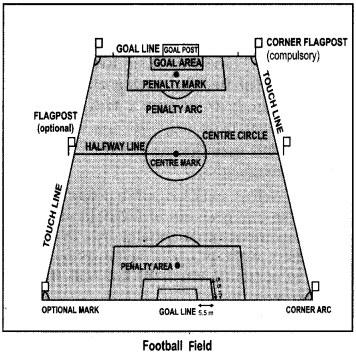
(b)
- You can trap both high and low balls with your foot in many different ways.
- You can trap balls on the ground, in the air and during or just after the bounce.
- You can trap the ball with the inside, outside, underside and top of the foot.
- There are two basic ways of trapping a high ball.
- One is to allow the ball to bounce up a little when trapping it.
- You can then play the ball on before it reaches the ground.
(c) The basic compulsory equipments required by a football player are :
- A jersey or shirt with sleeves.
- Shorts : If thermal undershorts are worn, they are of the same main colour as the shorts.
- Stockings
- Shinguards : These are covered entirely by the stockings. These are made of a suitable material (rubber, plastics or similar substances). They provide a reasonable degree of protection.
- Footwear
(d) Goal-kick : When the whole of the ball passes over the goal-line excluding that portion between the goal posts, either in the air or on the ground, having last been played by one of the attacking team, it shall be kicked directly into play beyond the penalty area from a point within that half of the goal-area nearest to the point where it crossed the line by a player of the defending team. A goal-keeper shall not receive the ball into his hands from a goal- kick in order that he may thereafter kick it into play. If the ball is not kicked beyond the penalty area i.e. directly into play, the kick shall be retaken. The kicker shall not play the ball a second time until it has touched or been played by another player. A goal shall not be scored directly from such a kick. Players of the opposite team shall remain outside the penalty-area until the ball has been kicked out of the penalty area.
A goal kick is awarded to the defending team when the ball goes out of the field of play by crossing either on the ground or in the air, the goal line, without a goal being scored, when the last person to touch the ball was from the attacking team.
(e) (i) IFAB : The International Football Association Board.
It is the body that determines the laws of the game of association football. IFAB was founded in 1886 to agree standardised laws for international competition, and has since acted as the “guardian” of the internationally used Laws; since its establishment in 1904 FIFA, the sport’s top governing body, has recognised IFAB’s jurisdiction over the Laws.
IFAB is known to take a highly conservative attitude regarding changes to the laws of the Game.
(ii) AIFF : The AIFF is a National Association registered with the Registrar of Societies, Mumbai, under the Societies Registration Act, 1860. The Headquarters of the AIFF is in Dwarka, New Delhi. AIFF is a member of FIFA, AFC and Indian Olympic Association and is self obliged to respect the Statues, Regulations, Directives and decisions of FIFA and AFC and to ensure that these are likewise respected by its members. Its main objective is to improve and popularise the game of football constantly and promote it throughout India in the light of its unifying, educational, cultural and humanitarian values, particularly through youth and development programmes to urban, rural and remote areas including Schools, Colleges and Universities. Its responsibility is to draw up regulations and provisions and ensure their enforcement.
CRICKET
Question 9. [3 x 5]
(a) State any five pre-match duties of the umpire. [5]
(b) Name any five different variations of spin bowling, in cricket. [5]
(c) Specify the measurement of the following : [5]
(i) Length and width of a bat
(ii) Circumference and weight of a ball
(iii) Length of wickets above the ground.
(d) Write any five instances when a ball becomes dead. [5]
(e) Explain the following terms : [5]
(i) An appeal (ii) Bump ball
Answer:
(a)
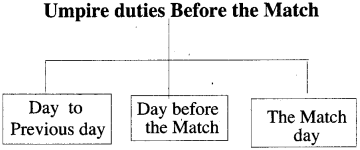
(a) Day n to Previous Day :
- Acknowledge the appointment and seek particulars relevant to the match. (Venue, Date, Teams, Partners, Scorers etc.)
- Connect with partner (s) and agree on the time to meet the venue on previous day.
- Revise laws and connect to public information relevant to the match or tournament.
(b) Previous Day :
- Meet partner as planned and jointly meet match and ground authority at the venue-aim to establish report.
- Enquire about weather, ground and light conditions affecting.
- Check facilities like drainage, cover at disposal etc.
(c) The Match Day :
- Umpire to be present on the ground and report to ground authority at least 45 mins before scheduled start to the match.
- Umpire have to inspect the playing field and satisfy that the things are fix or fit for play to start.
- Meet the scorers etc.
(b)
- Off spin or off break.
- Leg spin or leg break.
- Top spin.
- Googly.
- Arm ball (Right arm off-spin)
(c)
- Length 38 inches width 4-25 inches.
- Circumference-22-4 to 22-9 cms and Weight: 155-9 gms to 163 gms.
- 28 inches.
(d) A ball is dead in cricket when :
- It is finally settled in the hands of the wicket keeper.
- A boundary is scored.
- A batsman is dismissed.
- Lost ball.
- Whether played or not, it lodges in the clothing or equipment of a batsman or the clothing of an umpire.
(e)
(i) Appeal : Time of appeals. The umpires shall not give a batsman out unless appealed to by the other side which shall be done prior to the bowler beginning his next delivery.
An appeal “How’s that” ? shall cover all ways of being out. Answering appeals, the umpire at the bowler’s wicket shall answer appeals before the other umpire in all cases, except those arising out of 35 (Hit wicket) or 39 (Stumped) or 38 (Run out) when this occurs at . the striker’s wicket.
(ii) Bump Ball: A delivery that bounces very close to the batsman’s foot, after he has played a shot, such that it appears to have come directly from the bat without ground contact. The result is often the appearances of a clean catch.
HOCKEY
Question 10. [3 x 5]
(a) Draw a neat diagram of a hockey goal post, with all its dimensions. [5]
(b) Explain the rule of substitution in the game of hockey. [5]
(c) List five cups and trophies associated with the game of hockey in India. [5]
(d) Explain the following : [5]
(i) Shooting circle
(ii) Bully
(e) Write any five occasions when the
Answer:
(a) goal dimension
| Code | Metre | Code | Metre |
| A | 3.66 | E | Minimum 0.90 |
| B | 2.14 | F | 0.050 |
| C | 0.46 | G | 0.050 to 0.075 |
| D | Minimum 1.20 |

(b) The Rules of Substitution :
- There is no limit to the number of players who may be substituted at the same time nor to the number of times any player may substitute or be substituted.
- The substitution of a player may be made only after a player from the same team has left the field.
- Time shall not be stopped for substitutions except for goalkeepers.
- Substitutes shall not be permitted for suspended players during their suspension.
- After completing a suspension, a player may be substituted without first returning to the field.
- Players leaving or entering the field shall do so at the center-line or such other place on the side of the field decided by the umpires before the game.
(c)
| Cups | Trophies |
| (1) Agha Khan Cup | (1) Dhyan Chand Trophy |
| (2) Scindia Gold Cup | (2) Nehru Trophy |
| (3) Bombay Gold Cup | (3) MCC Trophy |
| (4) Rangaswami Cup | (4) Gurmeet Trophy |
| (5) Indira Gandhi Gold Cup | (5) Guru Nanak Trophy |
(d) (i) Hockey Shooting Circle : A semi-circle is drawn on the ground 16 yards in front of the goal, which is referred to as the shooting circle in Hockey.
- A goal is only awarded when the ball is touched inside the circle by an offender or defender and the goal is converted.
- The severity of the foul will be in higher degree when it is committed inside the circle.
- An intentional foul inside the circle will be awarded with a penalty stroke.
- An unintentional foul inside the circle will be awarded with a penalty comer.
(ii) Bully : It is a call used to start or restart play. The referee puts the ball between two opposing players. Two players of both the teams stand in front of each other. They touch this stick to the ground three times and alternately their opponent’s stick after that ball is put is play.
(e) Five occasions when the umpire shall blow the whistle in the game are :
- Start and end of each quarter of the match.
- Start a bully.
- Enforce a penalty.
- Start and end a penalty stroke.
- Indicate a goal.
BASKETBALL
Question 11. [3 x 5]
(a) Draw a neat diagram of the restricted area in basketball with all its dimensions. [5]
(b) Explain the procedure of substitution in the game of basketball. [5]
(c) Name any five types of passes in the game of basketball. [5]
(d) Mention any five duties of a scorer and an assistant scorer. [5]
(e) Explain the following terms : [5]
(i) Screening
(ii) Three Second Rule
Answer:
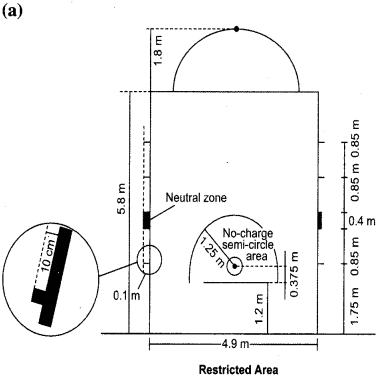
(b) The coach should send the substitute who must be ready to play to the Scorer. After reporting to the Scorer, the substitute must sit on the seat provided until the Scorer sounds his signal. He should then stand up and indicate to the nearer Official that he wishes to enter the court. He should not enter the court until beckoned to do so by an Official. If substitution is required during a charged time-out the substitute must report to the Scorer and the nearer Official before entering the court.
(c) The five types of passes, in the game of basket ball are as follows :
- Chest Pass
- Bounce Pass
- Baseball Pass
- Outlet Pass
- No-look pass
(d) Duties of the Scorer :
- The scorer shall keep a record of the names and number of players who are to start the game and of all substitute who enter the game. .
- The scorer shall keep a chronological running summary of the points scored, he shall record the Baskets made and free throws made or missed.
- He shall record the time-outs charged to each team and shall notify the coach through an official when he has taken a second time-out in each half or has no more time-outs left in a half or extra period.
- He shall also indicate the number of fouls committed by each player by raising, in a manner visible to both coaches and by using the numbered markers as provided.
- Effect substitutions.
Duties of Assistant Scorer : The assistant . scorer shall note when each half is to start and shall notify to the referee more than three minutes before this time so that he may notify the teams, or cause them to be notified, at least three minutes before the quarter is to start. He shall signal the scorer two minutes before starting time;
(e) (i) Screening : Screening occurs when a player attempt to prevent an opponent who does not control the ball from reaching a desired position on the court. Screening may be legal or illegal.
Legal screening occurs when the player who is attempting to screen an opponent is not in motion but standing still and has both feet on the floor. Illegal screening occurs when the player who is attempting to screen an opponent is moving when contact occurs with the player who is being screened. If that occurs, the screener is guilty of blocking and blocking is a foul.
(ii) Three Second Rule : A player shall not remain in the opponents restricted area for more than three consecutive seconds while his team is in control of a live ball in the front court and the game clock is running.
VOLLEYBALL
Question 12. [3 x 5]
(a) Write any five skills a volleyball player should possess. [5]
(b) Explain the following : [5]
(i) Blocking faults
(ii) Antennae
(c) List any five important duties of a volleyball referee. [5]
(d) State any five violations of rules that are punished by the referee. [5]
(e) State the dimensions of the following : [5]
(i) Circumference of the ball
(ii) Height of the net for men and women
(iii) Distance of attack line from the centre
(iv) Length of the net
(v) Length and breadth of the volleyball court.
Answer:
(a) Five fundamental skills required by a player :
- The service.
- The Net Recovery.
- The Block
- The Set-up
- The Attack (smash)
(b) (i) Blocking Faults : A blocker commits a faults when :
- He blocks outside the antennas and touches the ball in the opponents space.
- He interferes with the play of an opponent in the opponent’s space, either before or during the action.
- As a back line player he is effecting or participating in a block.
- He blocks the opponent’s service, (he may neither block nor attack in the front zone from higher than the top of the net).
(ii) Antennae : The antennas are two flexible rods made or fiber glass or similar material, 1.80 m long and 10 mm in diameter.
The antennas shall be marked with 10 cm bands of contrasting colours, preferably red and white.
Each is fastened on the outer edge of each vertical side band extending net and on opposite sides of the net. They are considered as parts of the net and mark its side limits.
(c)
- The referee initiates service, and controls the tempo of the game.
- The referee is primarily responsible for judgements regarding ball handling.
- The referee is only responsible for rotation of serving team.
- The referee has the duty of communication with umpire, captains and statistician.
- The referee performs the toss up from service and court.
(d)
- Consecutive Contacts : A player may not hit the ball 2 times consecutively except when blocking, provided the contacts take place simultaneously. However, a player may make consecutive contacts on the teams first team contact, provided the contacts occur during one action.
- Four Hits : It’s a violation for a team to hit the ball 4 times before returning it.
- Assisted Hit : It’s illegal for a player or any object to assist a teammate in playing the ball.
- Catch : It’s illegal to catch or throw the ball. The ball must rebound from the hit.
- Ball Crossing the Net Outside the Crossing Space : The ball must cross the net within the crossing space. The ball must cross over the net, between the antennaes and their imaginary extension, and without contacting the ceiling.
(e)
- 65 cm to 67 cm.
- 2-43 m for Men.
2-24 m for women. - 3 m
- 9-50 m
- Length : 18 meters.
Width : 9 meters .
TENNIS
Question 13. [3 x 5]
(a) Draw a neat diagram of the tennis court, with its dimensions. [5]
(b) Explain the pattern of scoring in the game of tennis. [5]
(c) Explain the following : [5]
(1) Let (2) Footfault
(d) State any five conditions when the service is considered to be a fault service. [5]
(e) Write the instances when a player hinders the opponent. What are the penalties for it ? [5]
Answer:
(a)
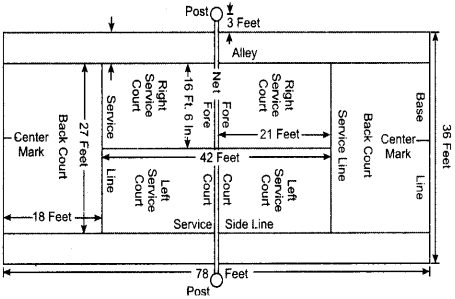
(b) The tennis scoring system is the standard system by which tennis matches and tournaments are generally operated and scored. A tennis tournament is organized into matches between players (for singles tournaments) or teams of two players (for doubles tournaments). The matches of the . tournaments are grouped into rounds. In round all players (or teams) are paired and play against each other in matches. The losers are said to leave, or be out. They no longer compete in the tournament (this is single elimination). The winner of the final round will go further for the other matches of the tournament. A tennis match is composed of points, games, and sets. Traditionally, matches are either a best of three sets or best of five sets format. The best of five set format is typically only played in the men’s singles or doubles matches at Majors and Davis Cup matches.
(c)
- Let : A serve is called a let when the ball hits the net cord but still lands in the service court. Such a serve is not considered a fault and the server may repeat the service attempt. A ball that hits the net cord but lands outside the service box is still a fault.
- Foot Fault : Foot faults occurs when the player is serving and he steps on or over the line before making contact with the ball.
(d) Five conditions when the service is considered to be a fault are :
- When the server touches inside the court while serving.
- Two consecutive service faults leading to lose on point.
- If the players miss the ball in attempting to strike it.
- If the ball goes in the side gallery.
- If the ball served touches the permanent fixture other than the net, strap or band.
(e) Player Hinders Opponent : If a player commits any act which hinders his opponent in making a stroke, then, if this is deliberate, he shall lose the point or if involuntary, the point shall be replayed.
BADMINTON
Question 14. [3×5]
(a) List any five duties of an umpire. [5]
(b) Explain the method of testing the speed of a shuttle. [5]
(c) List any five basic skills required by a player, in the game of badminton. [5]
(d) Define the following : [5]
(i) Smash shot
(ii) Drop shot
(iii) Drive shot
(iv) Clear shot
(v) Toss or lob shot
(e) State the following dimensions : [5]
(i) Height of the net at the centre
(ii) Length and width of the racket
(iii) Weight of the shuttle
(iv) Number of feathers in a shuttle
(v) Width of the court lines.
Answer 14.
(a) Duties of umpire before and during match : Before:
- Check all the equipments are according law.
- Check all measurements of court.
- See all officials are on their places.
During:
- Uphold and enforce the laws of game.
- Give a decision on any appeal.
- Appoint or remove line judges.
- Record and report to’ the referee all matters.
(b) To test a shuttle, a player shall use a full underhand stroke which makes contact with the shuttle over the back boundary line. The shuttle shall be hit at an upward angle and in a direction parallel to the side lines.
A shuttle of correct speed will land not less than 530 mm and not more than 990 mm short of the other back boundary line as in Diagram B.
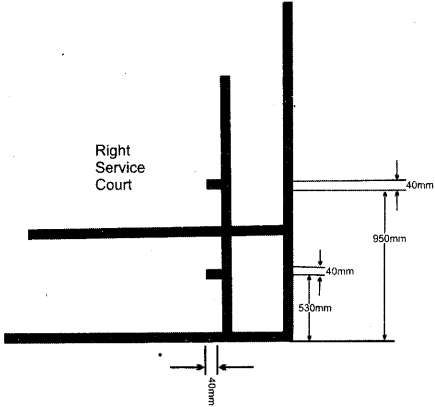
(c) Fundamental skills required by a player :
- Correct footwork,
- Service
- Lob
- Drop
- Smash
- Back hand
- Net Play
(d)
- Smash : It is a powerful stroke which pushes the shuttle cock to move downwards sharply. This is the most important and point winning stroke.
- Drop-Shot: It is a very soft shot that can help in winning points if played well. This stroke can be executed from forehand and backhand sides in the frontcourt of the opponent. Drop-shots are of two types—fast and slow drop-shots.
- Drive Shot : It is a stroke in which the shuttle crosses over a net in a horizontal or flat trajectory. It can be played from both forehand and backhand sides. It is prominently used in the game of doubles a player intends to keep the shuttle as low as possible.
- Clear Toss : This is the most common and important of all badminton strokes that can be played overhead or underarm and can be executed from both forehand and backhand sides of the court. The clear can be of attacking (flat) and defensive (long and high) in nature,
- Toss or Lob Shot : Prior to the start of a game, there will be a toss. The winner of the toss makes a decision to choose an end of the court or to serve first. If the player chooses the court, the opponent player will serve first. On the other hand, lobbing or lob shot is a stroke executed at the baseline, hitting the ball far to the back of the opponent court. Any good lob should be over the opponent’s reach at mid court, hence pushing them to the back of the baseline.
(e)
- 5 Ft high in the centre.
- L = 680 mm.
W = 230 mm. - 4.75 – 5.50 gms.
- 16
- 6-1 m full width of the court from the centre line dividing the width of the court.
SWIMMING
Question 15. [3 x 5]
(a) Explain synchronised swimming and marathon swimming. [5]
(b) State the duties of the following : [5]
(i) Judges of stroke
(ii) Recorders
(c) Classify the different types of races in swimming. [5]
(d) Name any five important swimming tournaments. [5]
(e) Explain the following. [5]
(i) Lane ropes
(ii) Automatic officiating equipment.
Answer 15.
(a) (1) Synchronized Swimming : Synchronized swimming is a hybrid of swimming performing a synchronized routine of elaborate move in the water accompanied by music. It demands advanced water skills and required great strength,- endurance etc. Synchronized swimming is both an individual and team sport.
(2) Marathon Swimming : Marathon swimming is a continuous open water swimming of at least 10 km. This distance was chosen for its equivalence in time-to- completion to a 26-2 mile marathon run.
(b) (1) Judges of Strokes : At the start, the stroke Judge is responsible for observing the swimmers at the 15 meter mark for all strokes except the breaststroke. After the start, the Stroke judge walks the sides of the pool, preferably abreast of swimmers during all strokes except freestyle. The breaststroke and butterfly are best judged by walking slightly behind the swimmers. Judges should walk at a pace that is sufficient to stay with the swimmers. If the field spreads out, the stroke judge should maintain a position slightly ahead of the trailing swimmers while maintaining contact with the lead swimmer (s). If there are two (2) stroke judges working one side of the pool (usually in long course meets), a “lead- lag” observation pattern could be utilized as the field spreads out.
(2) Recorders : Record withdrawls from the competition, enter results on official forms and maintain record for team awards as appointment.
(c) Types of races in swimming are as follows :
- Freestyle
- Back stroke
- Breast stroke
- Butterfly
- Individual medby
- Relays.
(d) Five important swimming tournaments are:
- FINA Swimming World Cup
- European Masters Swimming
- Swedish Swimming
- Australian Swimming.
- World Open Water Championships.
(e) (1) Lane Ropes : They shall extend the full length of the course, secured at each end wall to anchor brackets recessed into the end walls. Each lane rope will consists of floats placed end to end having a minimum diameter of 5 cm to a maximum of 11 cm. The colour of the floats extending for a distance of 5-0 m from each end of the pool shall be distinct from the rest of the floats. There not be more than one lane rope between each lane.
(2) Automatic Officiating Equipments :
Automatic Officiating Device is used in any competition. The placings and timings so determined shall have precedence over the decisions of human judges and timers.
ATHLETICS
Question 16. [3 x 5]
(a) Draw a neat diagram of standard 400 m track, with all its dimensions. [5]
(b) List the fundamental skills required by an athlete, for hammer throw. [5]
(c) What is false start ? Explain any two types of finishing techniques. [5]
(d) Write any five duties of the call-room manager. [5]
(e) Explain the following : [5]
(i) Exchange zone
(ii) Starting blocks.
Answer 16.
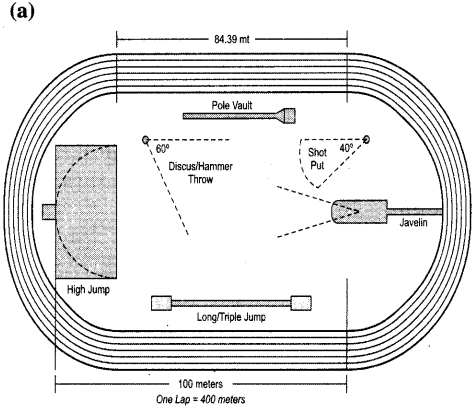
400-meter Run : One full lap around an outdoor track. Runners remain in their assigned lanes and receive staggered starts. Although competitors begin in starting blocks and the 400 is technically considered a sprint the runners must pace themselves a bit. Come from behind victories.
(b) Hammer throw is a sport in athletics (track and field) in which a hammer is hurled for distance, using two hands with a throwing circle.
Grip : The athlete’s left hand, wearing the glove, grips the handle between the 2nd and 3rd joints of the fingers and the right hand is then placed inside the handle on top of the left hand.
Swings : The thrower stands at the rear of the circle, feet parallel, with back towards the throwing sector. The preliminary swings are used to commence momentum of the throw.
Entry : At the end of the swings, the athelete is about to enter the turning phase. With the hammer directly in front of the thrower, the hammer is pushed to the left and the turns are started.
Turns : The number of turns performed is a personal choice, but in general 3 or 4 are used. These are a series of movements performed to increase the speed of the hammer using balance through the feet, and power from the legs and hips. The feet works together throughout the throw. The left foot is rotated into the first turn. The left foot is rotated 180° on the heel towards the direction of the throw, and the right foot rotates 180° on the toe. The thrower then picks up the right foot, brings it fully around and places it on the ground parallel to the left. This completes one turn. The elite throwers usually perform 3 or 4 turns, whereas the beginners perform one or two turns.
Releasing of Hammer : After the turns performed by the thrower have accelerated the hammer head to its maximal velocity, the thrower now stays with both feet in contact with the circle but still rotating and, at the same time, extending through ankles, knees and hips to drive the hammer upward and out to a position opposite the low point, known as the high point, at which point the hammer is released. In the drive upward, the feet are pointing at “9 O’clock” and the left side of the body is blocked.
(c) A false starts is a movement by a participant before (or in some cases after) being signaled or otherwise permitted by the rules to start. Depending on the sport and the event, a false start can result in a penalty against the athlete’s or team’s field position, a warning that a subsequent false start will result in disqualification, or immediate disqualification of the athlete from further competition.
Generally, the athletes use three types of finishing techniques which are mention below :
- Run through : This technique is generally adopted by novice athletes. In this technique, the finishing line is crossed with the full speed by the athletes.
- Lunging : In this technique, the athlete bends his ‘torso’ towards the finishing line in the last stride. This technique is adopted by experienced or well experienced athletes.
- Shoulder shrug : An athlete tends to bend his one shoulder and the complete action is performed in the last stride near the finishing line by the extraordinary athletes.
(d) Duties of call room manager are :
- Organise the call room area.
- Brief the team.
- Attend the technical meeting.
- Organise the team.
- Receive and relay any messages.
(e)
- Exchange Zone : It is an area of the track where the baton is passed from one runner to the other during a relay race.
- Starting Block : It is a device used in the sports of track and field by sprint athletes to hold their feet at the start of a race so they do not slip as they push out at the sound of the gun.
